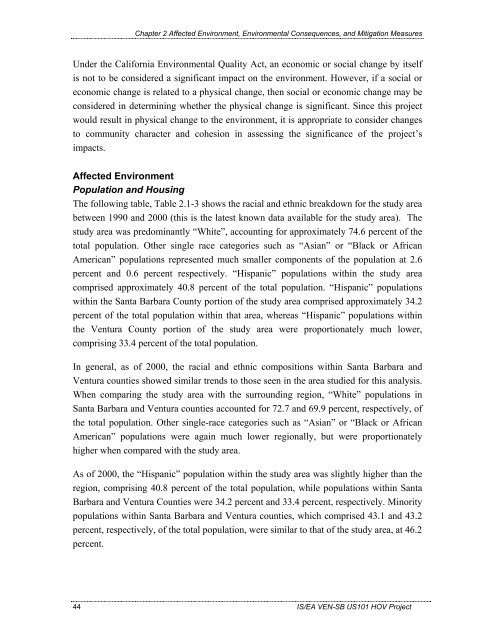Chapter 1 - Caltrans - State of California
Chapter 1 - Caltrans - State of California
Chapter 1 - Caltrans - State of California
Create successful ePaper yourself
Turn your PDF publications into a flip-book with our unique Google optimized e-Paper software.
<strong>Chapter</strong> 2 Affected Environment, Environmental Consequences, and Mitigation Measures<br />
Under the <strong>California</strong> Environmental Quality Act, an economic or social change by itself<br />
is not to be considered a significant impact on the environment. However, if a social or<br />
economic change is related to a physical change, then social or economic change may be<br />
considered in determining whether the physical change is significant. Since this project<br />
would result in physical change to the environment, it is appropriate to consider changes<br />
to community character and cohesion in assessing the significance <strong>of</strong> the project’s<br />
impacts.<br />
Affected Environment<br />
Population and Housing<br />
The following table, Table 2.1-3 shows the racial and ethnic breakdown for the study area<br />
between 1990 and 2000 (this is the latest known data available for the study area). The<br />
study area was predominantly “White”, accounting for approximately 74.6 percent <strong>of</strong> the<br />
total population. Other single race categories such as “Asian” or “Black or African<br />
American” populations represented much smaller components <strong>of</strong> the population at 2.6<br />
percent and 0.6 percent respectively. “Hispanic” populations within the study area<br />
comprised approximately 40.8 percent <strong>of</strong> the total population. “Hispanic” populations<br />
within the Santa Barbara County portion <strong>of</strong> the study area comprised approximately 34.2<br />
percent <strong>of</strong> the total population within that area, whereas “Hispanic” populations within<br />
the Ventura County portion <strong>of</strong> the study area were proportionately much lower,<br />
comprising 33.4 percent <strong>of</strong> the total population.<br />
In general, as <strong>of</strong> 2000, the racial and ethnic compositions within Santa Barbara and<br />
Ventura counties showed similar trends to those seen in the area studied for this analysis.<br />
When comparing the study area with the surrounding region, “White” populations in<br />
Santa Barbara and Ventura counties accounted for 72.7 and 69.9 percent, respectively, <strong>of</strong><br />
the total population. Other single-race categories such as “Asian” or “Black or African<br />
American” populations were again much lower regionally, but were proportionately<br />
higher when compared with the study area.<br />
As <strong>of</strong> 2000, the “Hispanic” population within the study area was slightly higher than the<br />
region, comprising 40.8 percent <strong>of</strong> the total population, while populations within Santa<br />
Barbara and Ventura Counties were 34.2 percent and 33.4 percent, respectively. Minority<br />
populations within Santa Barbara and Ventura counties, which comprised 43.1 and 43.2<br />
percent, respectively, <strong>of</strong> the total population, were similar to that <strong>of</strong> the study area, at 46.2<br />
percent.<br />
44 IS/EA VEN-SB US101 HOV Project

















